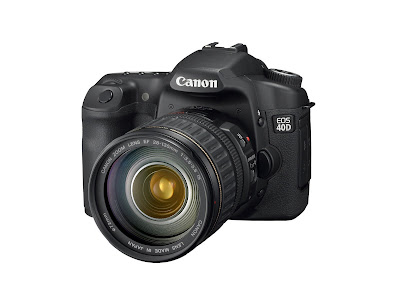
Canon 100mm Macro lens is great for taking macro shots using Canon 40D. I have got one now but waiting to find a subject like this. Guess I am going to need a lot of patient. While I work on taking my macro shots, here is one from ashleyhampson.
Canon 40D is my current digital SLR. I have been very excited since I got my hands on this beauty. I purchased my Canon 40D with Canon 100mm Macro lens. Then I went back and purchased 28-135mm USM IS lens (don't ask why). Canon 40D is the most expensive dslr I have ever purchased. It officially started me as a hobby photographer.


When it comes to measuring camera speed, autofocus is a key factor. If a camera's AF system does not meet photographers' demands and lock focus accurately and quickly, they will miss shots regardless of the camera's shot-to-shot speed or start-up time. The E-3's new AF system is the world's fastest in combination with the ZUIKO DIGITAL SWD ED 12-60mm f2.8-4.0 lens, to ensure fast focus for clear, sharp photos. Additionally, every lens attached to the E-3 benefits from faster AF, not just the SWD lenses, so the E-3 can lock focus on a fast-moving subject and capture that once-in-a-lifetime shot.
The secret to the camera's high-speed focusing is a unique Twin cross type (fully biaxial) 11 point AF sensor, based on proprietary Olympus micro-sensing technologies, that achieves equally effective performance on both the vertical and horizontal axis. With most biaxial sensors, performance on the vertical and horizontal axes is not equal, and there is often a perceived difference in response time when using different lenses. However, unlike systems that respond at nominally lower f-stop values simply by boosting sensitivity, the E-3's AF sensor features a totally redesigned hounds tooth-pattern phase detection sensor layout that uses micro-lamination technologies to achieve superior real-world performance.
AF accuracy is further ensured by precise alignment of the optical axis from the lens to the AF phase detection sensors, and accurate mounting of the sensors within the AF unit. The AF unit used in the E-3 is made of high-tensile engineering plastic, which is further protected by the camera's high-rigidity magnesium body. In addition, data from a dedicated temperature sensor is used to compensate for changes in operating temperature.
The 11 AF target points on the E-3 can be selected to work individually or dynamically in combination with adjacent target points. Once a photographer knows the general direction of a moving subject - a Formula One racecar zooming around a track for example - the AF area can be selected based on the anticipated motion to maintain accuracy.
The newly developed Olympus Supersonic Wave Drive (SWD) lenses on the E-3 enable auto focusing at ultra-high speed with precise and quiet operation. Quietness is essential when shooting in a situation where silence is truly golden, such as photographing exotic birds up close in the wild or musicians at a classical music quartet. But this technology truly shines in combination with three new Olympus ZUIKO DIGITAL SWD lenses that employ Supersonic Wave Drive motor technology inside: the ED 12-60mm f2.8-4.0 SWD (24-120mm equivalent); ED 50-200mm f2.8-3.5 SWD (100-400mm equivalent), and the ED 14-35mm f2.0 SWD (28-70mm equivalent). The new ED 50-200mm f2.8-3.5 SWD lens focuses twice as fast as the previous ZUIKO DIGITAL lens with that focal length, and the new ED 14-35mm f2.0 joins the existing 35-100mm f2.0 (70-200mm equivalant) as the brightest lenses in their class. Mechanical focusing is also available for easy and accurate manual focusing by hand.
The E-3 can capture images at the highest image-quality setting at a rate of 5 frames per second. With shutter speeds of up 1/8000 second, it is possible to freeze action when photographing a cheetah in fast pursuit across the plain, or a fastball before it connects with the bat.
"Overall, the Canon EOS 40D is a more than able update of the 30D and since the introduction of the first Canon prosumer DSLR, the 3.1-megapixel EOS D30 back in 2000, it is light years ahead on that base line.On a personal note, I couldn't be more happier than my Canon 40D. I have said it again and again because it's true. Recently a friend of mine, for whom I took some photos at an event, told me that my photos were "insane", which made me really happy. He told me that every time the photos turn out so bad. He was so happy that he invited me to another event. My friend, Ronald, is also very happy with his photos. He was just showing me some very clear photos of rain he took in very low light conditions with his 50mm f1.4 lens, which I have been dying to get.
In a nutshell, this is a cracking camera and one marred only by the odd metering performance, otherwise it is quite simply excellent and worth a close inspection for anyone either trading up or for those pros’ that need a back up body that is not a compromise to far."
| canon eos 40d | canon 40d | eos 40d | 40d |
Quick camera response empowers you to capture every fleeting photo opportunity. When such moments arise, you can quickly start up the EOS 40D in only about 0.15 seconds. Then capture the scene at an impressive 6.5 frames per second in the continuous shooting mode, with up to 75 Large/Fine JPEG shots per burst. This speedy response was made possible by accelerated 4-channel reading and an optimized shooting sequence. You can also select a low-speed 3fps setting, depending on your needs. Response is further enhanced by a minimal shutter release time lag of 59ms. The shutter has a maximum speed of 1/8000 sec. and high speed X-sync at 1/250 sec.
